If you’ve been wondering what a mirrorless camera actually is, this article will give you a clear and not too technical to understand explanation.
Definitely worth the read if you’re considering shopping for one of the many mirrorless cameras available ( or soon to be available) ….
Mirrorless Cameras: A Buying Guide
By Eric Reichbaum
Mirrorless cameras have been on the market for a decade, but they have really begun to make waves in the past few years. Most serious photographers would have certainly been shooting with a DSLR camera just a few years ago, but now many have traded in their DSLRs for the smaller and lighter form factors that mirrorless cameras provide.
Not only are mirrorless cameras usually lighter and smaller than their DSLR counterparts, but they’re quieter, as well. With no mirror to slap up and down, street photographers, as well as wedding and theater photographers can now shoot virtually unnoticed.
Choosing a mirrorless camera can be a daunting task with lots of options, from sensor size, to video capabilities, to lens systems, and more. We will cover them all, and give you the information you need. Buying your new camera should be an exciting experience, so let this guide help you make an informed decision.
Lens Systems
What differentiates mirrorless cameras from other compact cameras is the fact that they have interchangeable lenses. This makes a world of difference, and if you’ve never had an interchangeable-lens camera, you will be quite surprised by how it will change your photography.
Compact point-and-shoot cameras have a built-in lens that typically gives you an optical zoom with a variable aperture and small sensor. What this means is that while you might have the ability to shoot both wide and telephoto zoom lengths, you don’t have as much control over selective focus or shallow-depth-of-field techniques.
Selective focus, often accentuated by pronounced bokeh, is one of the first things that people notice about photos taken with larger sensor, interchangeable-lens cameras, because now you have the option to shoot with a long zoom lens with an f/2.8 aperture, or a prime portrait lens with an f/1.4 aperture.





0 comments